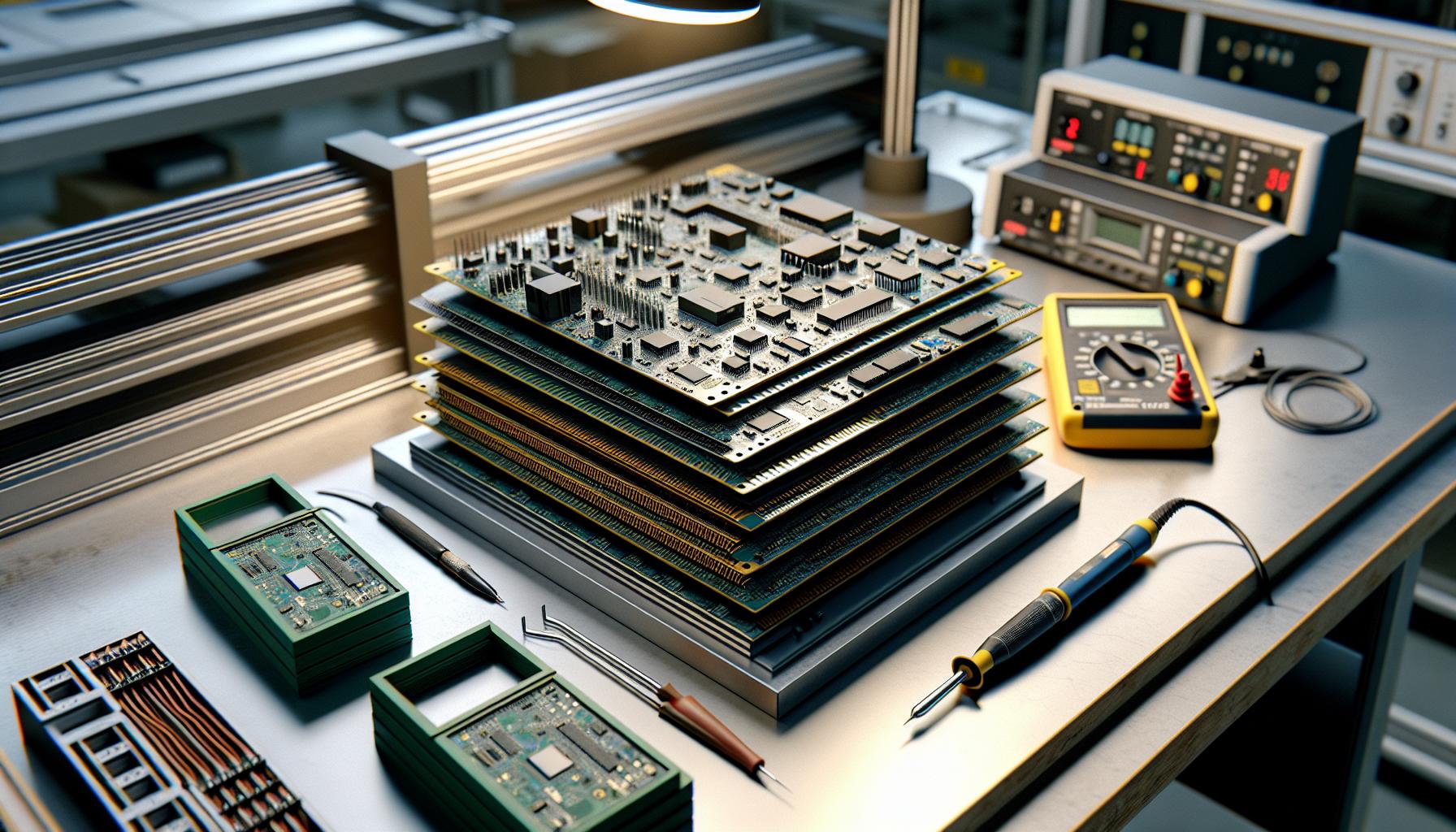Choosing the right PCB thickness is crucial for ensuring optimal performance and reliability in electronic devices. It impacts everything from signal integrity to thermal management, making it a key consideration for engineers and designers alike. This article explores the factors influencing PCB thickness selection, helping readers make informed decisions that align with their project requirements.
Understanding PCB Thickness
PCB thickness plays a crucial role in the performance and reliability of electronic devices. Common thicknesses range from 0.2 mm to 3.2 mm, but 1.6 mm remains the standard thickness for many applications. Selecting the right thickness depends on several factors, including electrical performance, mechanical strength, and thermal conductivity.
Electrical Performance: Thicker PCBs may reduce signal loss, but they can also increase capacitance, which may not be ideal for high-frequency applications. For signal integrity, maintaining an optimal thickness helps minimize potential issues.
Mechanical Strength: Thicker PCBs offer better mechanical support and durability. They withstand physical stress and are less prone to bending or breaking, especially in demanding environments.
Thermal Management: PCB thickness influences how heat dissipates. Thicker boards, when paired with proper thermal vias, improve heat transfer away from critical components, ensuring efficient thermal management.
Cost Considerations: Thicker PCBs often increase material costs and manufacturing complexities. Balancing performance needs with budget constraints ensures cost-effective designs.
Understanding PCB thickness encompasses evaluating electrical performance, mechanical strength, thermal management, and cost. These factors guide engineers and designers to choose the most suitable thickness for their specific project requirements.
Factors Influencing PCB Thickness

Several key factors influence the selection of PCB thickness, ensuring optimal performance in electronic devices.
Electrical Requirements
Electrical performance significantly dictates PCB thickness. Thicker PCBs typically reduce signal loss due to lower resistance and improved conductivity. Designers consider specifications such as impedance control and capacitance. For high-frequency applications, thinner boards may be more suitable, as thicker boards can introduce greater capacitance, affecting signal integrity.
Mechanical Considerations
Mechanical strength plays a crucial role in determining PCB thickness. Thicker boards offer enhanced durability and resistance to bending and warping, making them suitable for rugged environments. When assessing mechanical requirements, engineers evaluate the size and weight of components, vibration tolerance, and the overall robustness needed for the application.
Thermal Management
Thermal management is essential for maintaining performance in high-power applications. Thicker PCBs facilitate improved heat dissipation through enhanced thermal conductivity and proper layout design. Proper thermal vias and padding further aid in managing heat, preventing component failure. Engineers assess the expected thermal load and select thickness accordingly to ensure longevity and reliability of the PCB.
Common PCB Thickness Options
PCB thickness significantly influences performance. Common options include standard thicknesses and custom solutions designed to meet project requirements.
Standard Thicknesses
Standard PCB thicknesses typically range from 0.2 mm to 3.2 mm, with 1.6 mm being the most prevalent choice in many applications. Thicker boards, such as 2.0 mm or 3.2 mm, offer enhanced mechanical strength and improved durability, beneficial for demanding environments. For instance:
- 0.2 mm: Suitable for compact designs, often used in mobile devices.
- 0.6 mm: Common in consumer electronics where space is limited.
- 1.0 mm: Frequently used in moderate-density applications.
- 1.6 mm: The industry standard, ideal for a wide range of applications.
- 2.0 mm: Preferred for higher durability requirements.
- 3.2 mm: Selected for high-power or heavy-duty applications.
Custom Thickness Solutions
Custom PCB thickness options cater to specific electrical and mechanical performance needs. Customizations allow engineers to adjust thickness based on product requirements and constraints. Factors influencing the choice include:
- Electrical Performance: Thicker boards may reduce signal loss, while thinner options can minimize capacitance in high-frequency applications.
- Mechanical Strength: Custom thickness ensures adequate support for components, enhancing durability.
- Thermal Management: Tailored thickness improves heat dissipation efficacy, crucial in high-power scenarios.
Choosing the right PCB thickness ensures balanced performance, cost-effectiveness, and product reliability.
Choosing the Right Thickness for Your Project
Selecting the appropriate PCB thickness is critical for achieving optimal functionality in electronic products. Various factors influence thickness choices, including specific application requirements and the stage of production.
Application-Specific Requirements
Application requirements dictate the necessary PCB thickness. For instance, high-frequency circuits often benefit from thinner boards, as this minimizes capacitance and maximizes signal integrity. In contrast, applications involving high power necessitate thicker boards, which improve thermal management and provide mechanical strength. For compact designs, a thickness of 0.2 mm suffices, while thicker options, such as 3.2 mm, are recommended for high-power scenarios. Engineers must evaluate the demands of their specific application to determine the most suitable thickness.
Prototyping vs. Production
Prototyping and production phases can influence the choice of PCB thickness. During prototyping, thinner boards may suit initial tests, allowing for faster iterations and cost savings. However, transitioning to production often requires transitioning to thicker boards, ensuring durability and reliability. Manufacturers typically consider production needs, including mechanical stress and thermal performance, when finalizing thickness. Given these considerations, engineers should assess the differences between prototyping and production stages to align their thickness selection with the project timeline and objectives.
Conclusion
Selecting the right PCB thickness is essential for achieving the desired performance and reliability in electronic designs. Engineers must carefully weigh factors such as electrical requirements mechanical strength and thermal management to make informed choices. Understanding the implications of various thicknesses allows for better signal integrity and heat dissipation while balancing costs.
Ultimately a well-chosen PCB thickness not only enhances functionality but also contributes to the longevity of the device. By considering specific project needs and application demands engineers can ensure their designs meet both performance standards and budget constraints effectively.
Frequently Asked Questions
What is the importance of PCB thickness in electronic devices?
Choosing the right PCB thickness is crucial for optimal performance and reliability. It affects signal integrity, thermal management, and mechanical strength—key factors for engineers and designers in ensuring their products function effectively.
What are common PCB thicknesses used in applications?
Common PCB thicknesses range from 0.2 mm to 3.2 mm, with 1.6 mm being the standard for many applications. Specific thicknesses cater to varying needs, such as 0.2 mm for compact designs and 3.2 mm for high-power applications.
How does PCB thickness affect signal integrity?
Thicker PCBs generally reduce signal loss by lowering resistance and enhancing conductivity. However, in high-frequency applications, thinner boards are often preferred to minimize increased capacitance that can degrade performance.
What factors should be considered when selecting PCB thickness?
Key factors include electrical performance, mechanical strength, thermal conductivity, and cost. Balancing these elements helps engineers choose the best thickness to meet their project’s specific requirements.
Can thicker PCBs improve thermal management?
Yes, thicker PCBs can enhance thermal management, especially when paired with proper thermal vias. They improve heat dissipation and reliability, making them suitable for high-power applications that generate more heat.
Are there custom thickness solutions available for PCBs?
Yes, custom thickness solutions exist to meet specific electrical and mechanical performance needs. Engineers can tailor the thickness based on product requirements to achieve the desired functionality and durability.
Why might thinner PCBs be preferred during prototyping?
Thinner boards may be chosen during prototyping for quicker iterations and flexibility. However, production often requires thicker boards to ensure durability and reliability in the final product.
How does PCB thickness impact cost?
Thicker PCBs typically come with higher material costs and manufacturing complexities. It’s essential to balance performance requirements and budget constraints to achieve cost-effective solutions.

